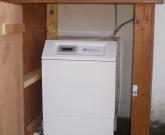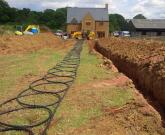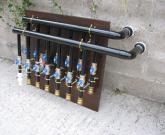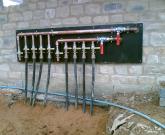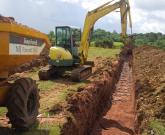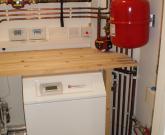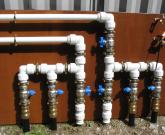HEAT PUMP HEATING
It is a sad fact that climate change is happening and this poses a huge threat to our world, the major cause of this is the release of greenhouse gasses.
To help reduce global warming we must reduce our Carbon Dioxide (Co2) emissions by using cleaner methods of generation and using energy more efficiently. Using a heat pump system to heat your home greatly reduces the energy required.
GROUND SOURCE HEAT PUMPS
Griffiths are an accredited 'Partner' installer of Kensa ground source heat pump systems. Kensa's heat pump range includes both 'High Temperature' and 'Low temperature' heat pump system, suitable for both new and older properties.
Ground source heat pumps work by absorbing heat energy from water being circulated through pipe work buried in the ground. A refrigeration circuit is used to amplify the low grade heat energy, which is transferred to the water circulating around a central heating system.
Ground source heat pump comprise of three main components:-
- The ground collector - Depending on the amount of ground available. These are either 'Slinkies', which are coils of pipe work which are buried horizontally in the ground. Where space is limited 'bore holes' can be used, in which a specialist contractor bores holes vertically in the ground and back filling the hole with pipe and a heat conducting grout.
- The heat pump unit - Kensa ground source heat units usually are floor standing. The unit contains two heat exchangers and circulating pumps. One to collect heat energy from the ground and one to release heat energy to the central heating system/hot water cylinder.
- Buffer Vessel - Buffer vessels are an essential component of a ground source heat pump. A body of water is used a 'buffer', this is to prevent the heat pump short cycling when small heating demands are placed on the system.
HOW DO GROUND SOURCE HEAT PUMPS WORK?
Although you may not know it, heat pumps are very familiar to us – Refrigerators and air conditioning units are both examples.
A heat pump utilises a refrigeration circuit to extract heat from one energy source, with ground source heat pump this is water circulating around pipe work buried in the ground. The refrigeration circuit amplifies the low grade heat (absorbed in the refrigerant) using a compressor, then via a heat exchanger distributes the heat energy to a property.
The ground collectors are often laid horizontally approximately 1.2 metres below the surface of the ground (often referred to as slinkies) or vertically where ground space is limited (bore holes).
The ground collectors are a closed circuit, containing an anti-freeze based fluid, which absorbs and carries low grade to energy from the ground to the heat pump system.
Ground source heat pumps come in greater capacities than air source heat pumps, therefore provide the perfect solution for heating larger properties when multiple air source units would be required.
KEY HEAT PUMP TERMS
'Slinkies' - Term often used to describe a horizontal ground collector. Often this is MDPE pipe work laid coiled approximately 1.2 metres below the ground surface. Approximately 4kW's of heat energy can be absorbed from a 40 metre long slinky ground collector.
'Bore hole' - Where ground space is limited for a horizontal collector, a bore hole might be a solution. A specialist contractor is employed to drill a hole vertically in the ground (To depths between 100-150m), the collector pipe is then spiralled up the hole back filled with a heat transfer grout.
The Installation Process
- For each installation Griffiths shall undertake a full survey of a property, estimating a room by room a property's 'heat loss'. For new build property's this can be undertaken from drawings.
- On existing homes a full appraisal of the existing central heating system shall be made, with recommendations of additional efficiency improvements which can be made.
- A bespoke heat pump system design is undertaken. A system shall be selected to meet seasonal and peak heating demands, with consideration of hot water usage. Local geological data is used the determine the thermal conductivity of the ground.
- A full quotation/system specification is produced detailing our selected system, estimations are provided of running costs and potential government funding.
- Installation of heat pump system.
- System commissioning and hand over.

 ,
, 
